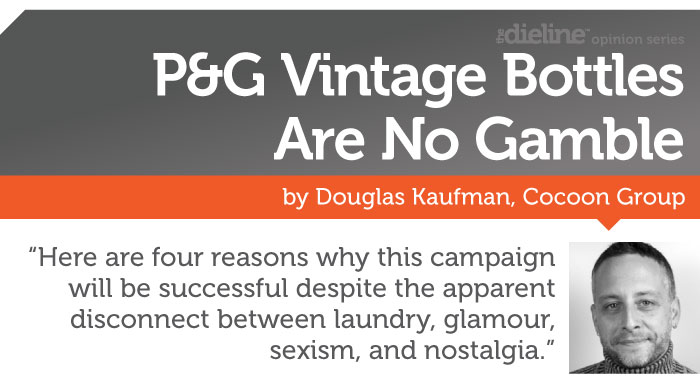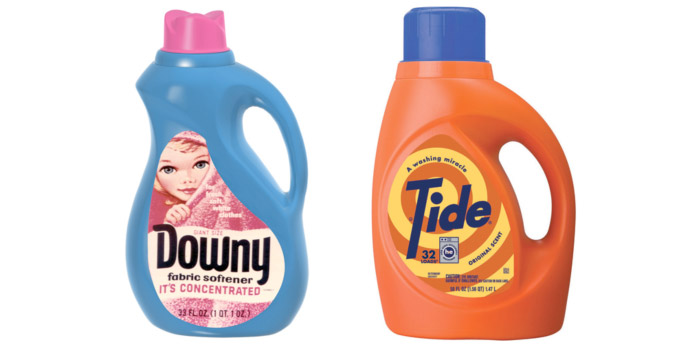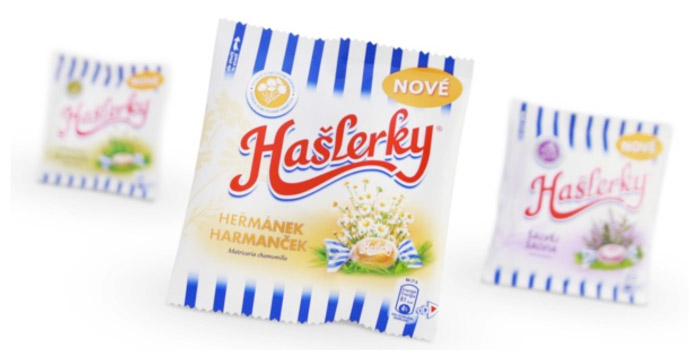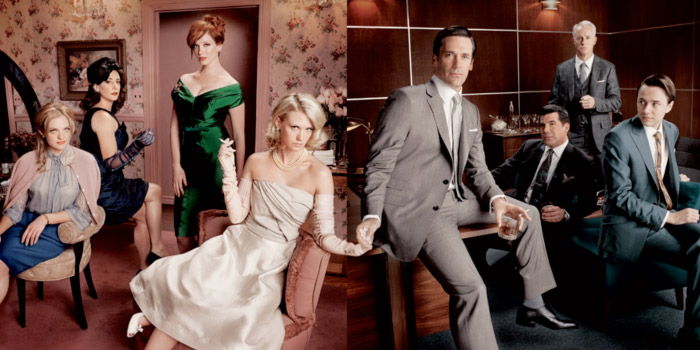 by Douglass Kaufman
by Douglass Kaufman
Suzanne Labarre, in a recent article for FastCoDesign, raised some doubts about P&G’s limited edition packaging campaign for Tide, Bounce, and Downy laundry products. In the campaign, running in American Target stores this summer, retro 1950’s packaging will be used to sweep customers back to an era when life was simple, uncomplicated, and there was only one (or two) real choices to tackle your dirty laundry.

two offending blasts from the past
Ms. Labarre points out in her article that, in order for the nostalgia effect of vintage packaging to work, there needs to be something to feel nostalgic for –and “the rigid gender roles of mid-century” certainly do not fit that bil. Even less appealing is the task of washing clothes themselves. Retro packaging works wonderfully for sexy categories such as automobiles, airlines, and cosmetics, where brands are trying to re-capture a mythical, glamorous past. “But who waxes nostalgic about washing someone else’s dirty underwear?” she asks.
The point is rational, and makes sense on that level exclusively. However in our experience, packaging -especially retro packaging -never works exclusively on a rational, straightforward level.
In Central and Eastern Europe, where our agency works, there has been a renaissance of sorts for heritage brands, and a good portion of our projects walk the tightrope between modernizing and ‘finding the magic’ that taps into childhood memories of a bygone (albeit socialist) era. Nowadays, the balance invariably tips toward finding that magic, and I believe that gives us a unique perspective on heritage brands, retro packaging, and how consumers react to both.

These great Haslerky packs were inspired by the packaging and ingredients of 19th century Czech pharmacies
Here are four reasons why this campaign will be successful despite the apparent disconnect between laundry, glamour, sexism, and nostalgia.
Simple times –not sexy times
Indentured servitude may be the first thing that comes to mind when you mentally parse the act of doing laundry in the middle of the last century. However, few people buying laundry detergent today suffered under the yoke of 1950’s domestic bliss. Instead, what most people will remember is their childhoods, playing securely and happily in the backyard while mom (or grandma) hangs up crisp white sheets to dry in the summer sun. This is the nostalgia into which P&G retro packaging fits. While it is not the glamour of Mad Men’s sex and alcohol fueled 1960s –it is still a powerful cocktail of emotions –few of which have anything to do with actual laundry.
In CEE, few people point to anything preferable or desirable about chores, work, or products during the time of socialism. However everyone universally thinks of their own childhood as a simpler, happier time imbued with a great deal of positive emotion. It is a well from which brand owners can almost always reliably draw –assuming their brands last a generation. 😉
Trendy (ok, kind of sexy after all)
We make a point of saying in the previous chapter that our safe, happy, childhood nostalgia is different from Mad Men’s sex-and-alcohol-fueled, glamorous nostalgia. However, make no mistake. There is a halo effect and P&G will benefit from it. Mad Men has made the early 60s cool and stylish and, again, the positive emotions that people (women) are feeling toward that time period (Johnathan Hamm) will bubble to the top when they see products that remind them of that period. The late 50s – early 60s are simply ‘hot’ right now and people are associating those times with positive emotions that overpower any niggling reservations about whether or not the physical act of washing socks is really sexy. We’re talking about the same level of emotion that gives 1969 flower power motifs instant credibility as environmentally friendly, regardless of the product. While the late 60s is revolutionary, casual, and natural, the early 60s are definitely glamorous, distinguished, and above all, sexy.

they’re all thinking about dirty socks!
Novelty.
Novelty generally works whether or not you buy into the message behind it. It gets people’s attention. It’s fun. And it’s for a limited time. We’re not making a political statement here after all, we’re just having some fun with our packs for a couple of months this summer. Consumers will notice the pack. They may crack a smile. And, few more bottles will be sold. It’s unlikely that, for any shopping housewife, these bottles are going to dredge up images of stifling gender discrimination.
Timelessness
The final reason for the success of this campaign is the most subtle and yet, to my mind, most powerful. In a category that churns competitors and sees the introduction of new products and features almost weekly, it is difficult to move the conversation away from “newest, latest, most advanced”.
Vintage packaging creates a platform on which these particular brands can stand up and say –“hey, we’ve been here and we’ve been leaders for over 50 years.” It is a claim that very few other brands could live up to and further caters to the desire for security and stability that consumers in the current economic climate are clamoring for.
So, while I agree with the conclusion that housecleaning in the 1950s hardly seems like a winning horse when it comes to advertising laundry products, these bottles nevertheless will work for a variety of other reasons –none of them having anything to do with the act of housecleaning itself. A retro campaign such as this works as a sort of date night between the consumer and the brand. For a limited time, the practicalities and the every day realities of product usage and chores are forgotten and everyone involved basks in the glow of simple, happy emotions from a time when the relationship was young.
It is a formula that has worked countless times in categories, and I have no doubt that it will work now for P&G.
-Douglas Kaufman
Originally from Boston, MA, Douglas came to Prague 20 years ago, following rumors of an enchanting city where the women were beautiful and the beer flowed like wine.
He is currently Head of Strategy for Cocoon Group, an award winning branding and design agency with offices in Moscow, Prague, Bucharest, and (through our sister agency, Mountain Design), the Hague.





